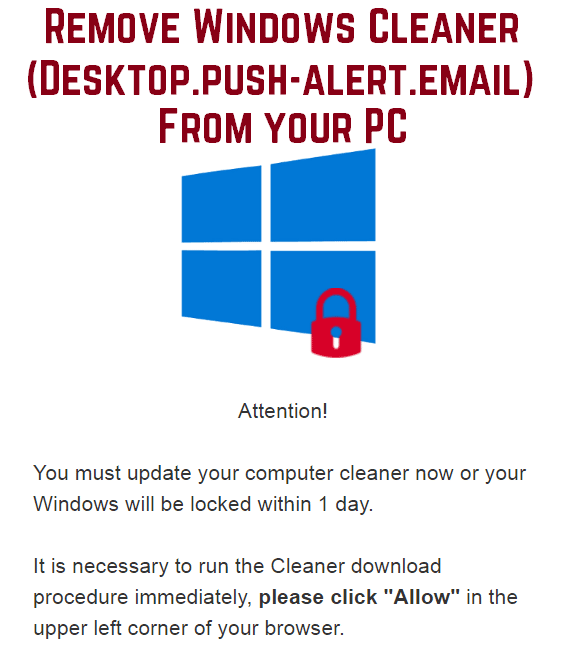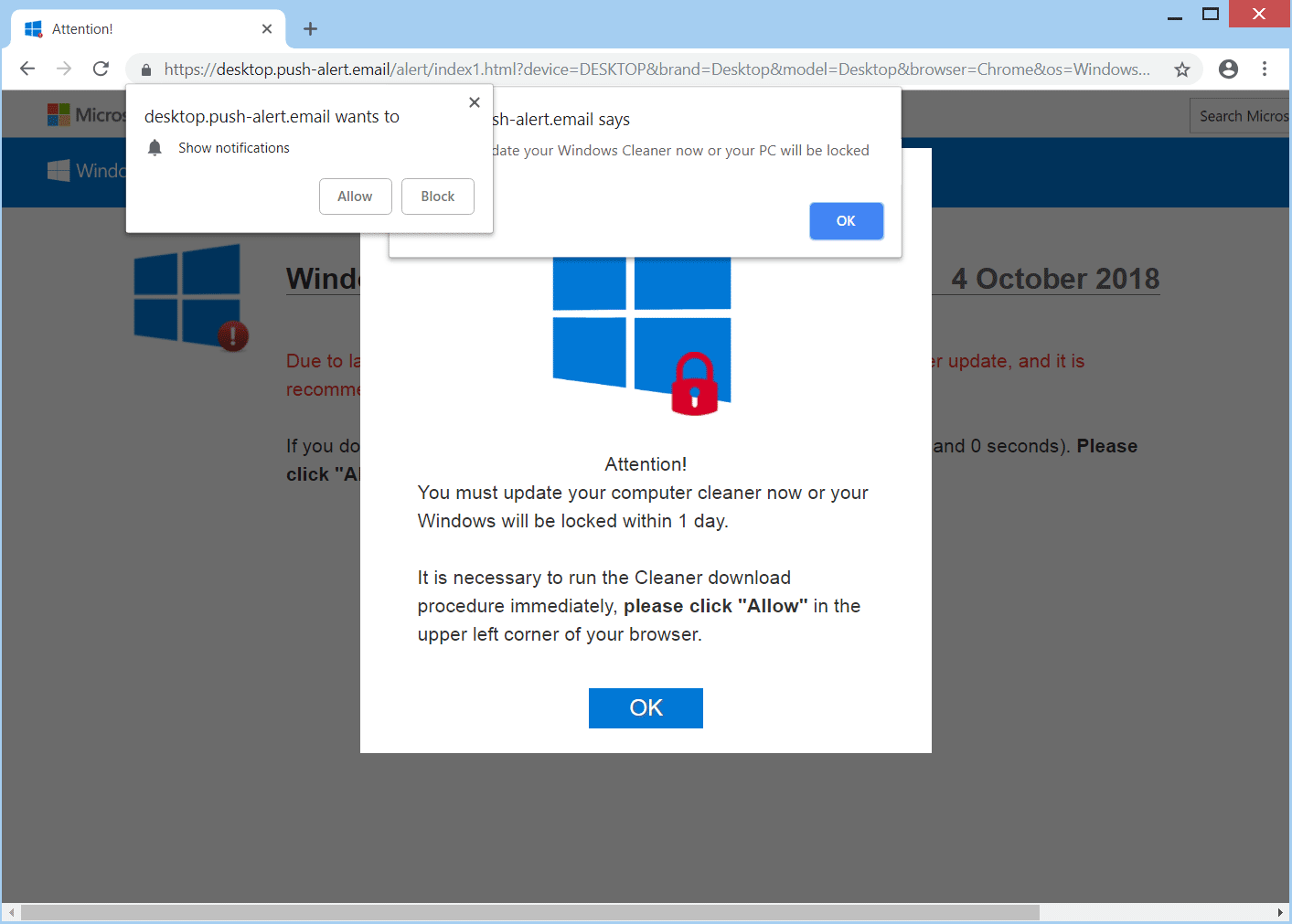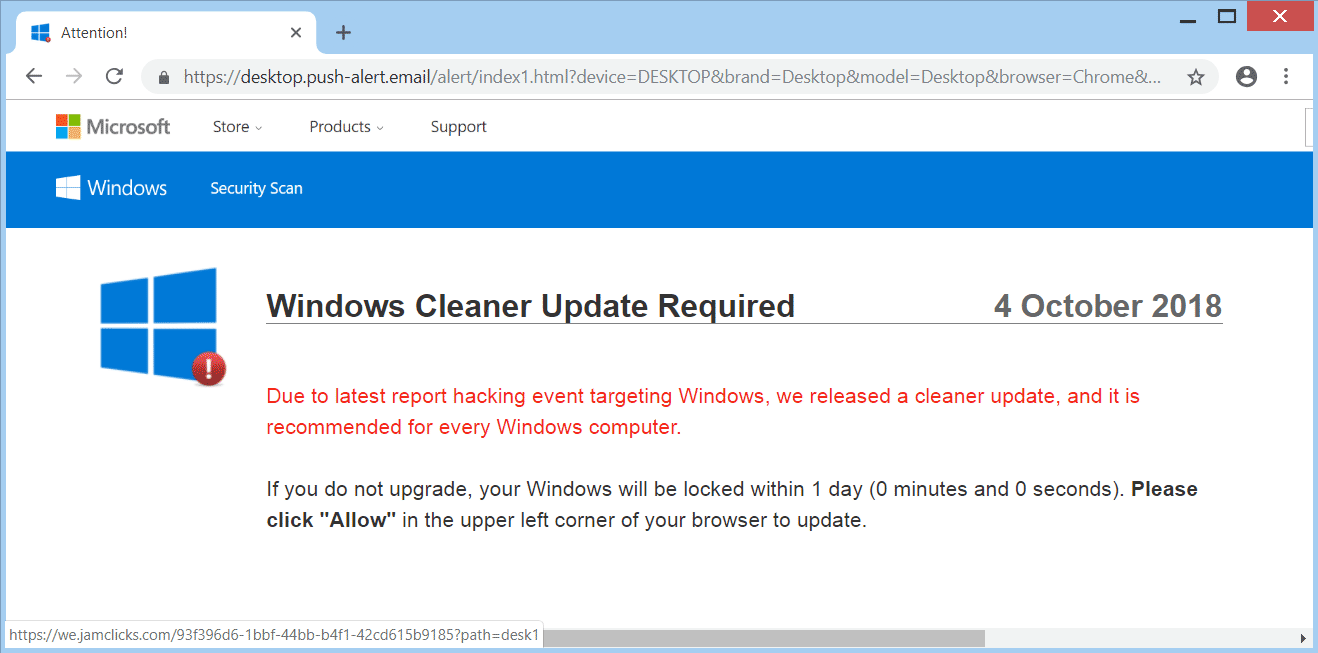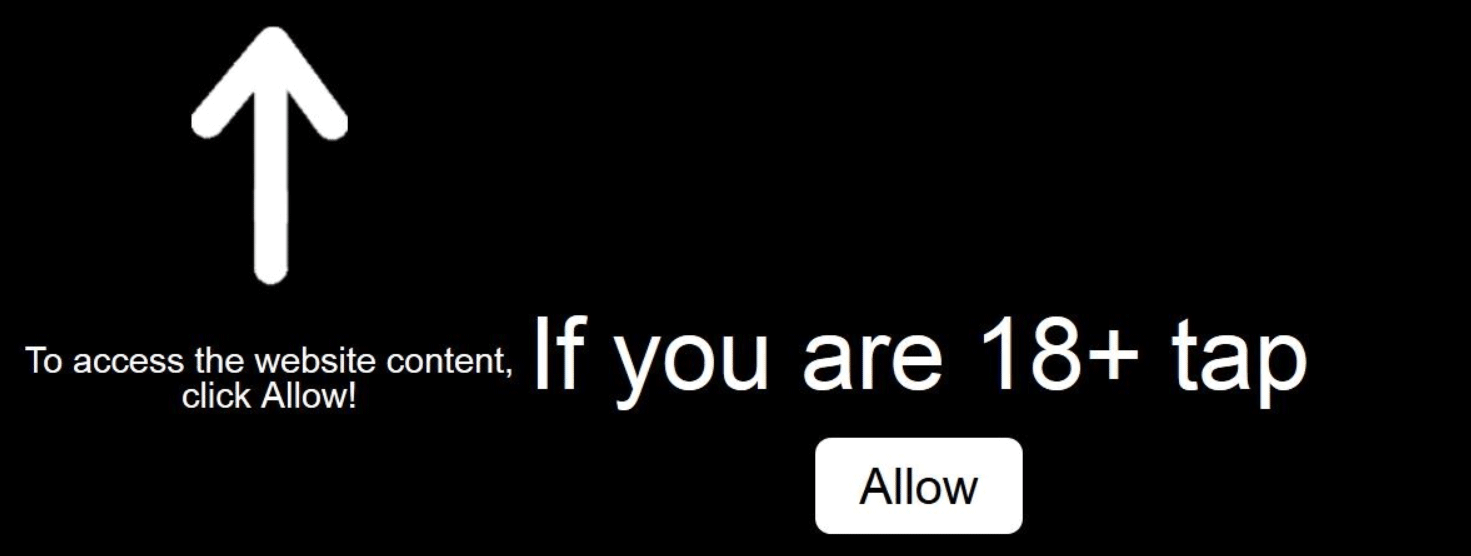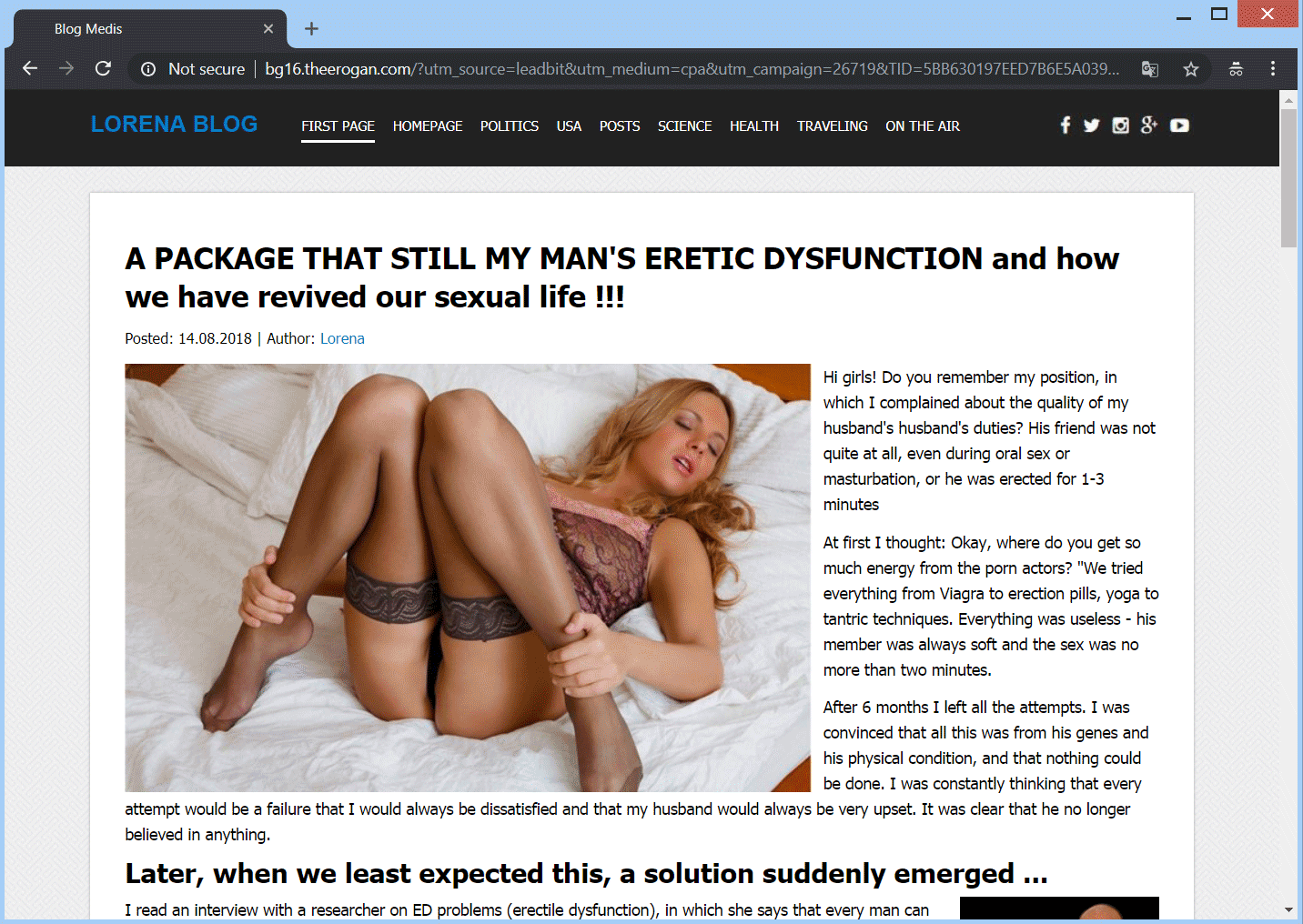This article will aid you to remove the Desktop.push-alert.email (Windows Cleaner Update) scam completely. Follow the tech support scam removal instructions at the end of the article.
Desktop.push-alert.email is a domain that hosts a tech support scam with a message stating that you need to make an update to get the latest version of Windows Cleaner whatever that may be referring to. Pop-ups that show constantly lock your browser on that current landing page. You will also experience multiple redirects, not only when you click somewhere, but even just by moving the mouse cursor. The browser can be shut down in some cases, without any negative effects, but in other ones your computer and browser might get affected further with more malware. Most variants of this scam feature a background image that aims to look like an official Microsoft Security Essentials window or something similar, but all of them use the Windows logo and

Threat Summary
| Name | Desktop.push-alert.email (Windows Cleaner Update) |
| Type | Tech Support Scam |
| Short Description | Tech support scams which are trying to scare you that you must download a Windows Cleaner Update from Desktop.push-alert.email or another site. The scam tries to scare you that without your update you cannot clean viruses on your PC. You might see a phone number to a supposed Microsoft tech support team. |
| Symptoms | Pop-up boxes, messages, and redirects appear in your browser. It is not excluded for there to be a lockscreen function among these, or your computer to be freezing because of the activity going on in your browser. |
| Distribution Method | Freeware Installers, Suspicious Sites, Redirects |
| Detection Tool |
See If Your System Has Been Affected by malware
Download
Malware Removal Tool
|
| User Experience | Join Our Forum to Discuss Desktop.push-alert.email (Windows Cleaner Update). |

Desktop.push-alert.email (Windows Cleaner Update) Scam – Spread
Browsing the Web can be dangerous, especially when you reach new and unknown websites by causally browsing and they turn out to be malicious. Clicking on advertisements or targeted content could have hidden links that redirect you to dubious online places. That is the most common way in which this kind of a tech support scam can use for its spread. Other websites could be filled with advertisements and redirect links and you could land on a page such as the Desktop.push-alert.email (Windows Cleaner Update) one.
One of the domains spreading this tech support scam is https://desktop.push-alert.email/alert/index1.html?.
Freeware applications, regarded as PUPs (potentially unwanted programs) could also distribute this sort of scam. Different software could cause the scareware to appear in your browsers or another related Microsoft Tech Support scam. Such websites usually come with third-party installations and freeware packages. These packages tend to have extra features selected for installation from the get-go. To avoid installing any additional features could be done if you find Advanced or a Custom settings.

Desktop.push-alert.email (Windows Cleaner Update) Scam – Details
Desktop.push-alert.email, that pushes the Windows Cleaner Update message, is one of a few domains directly connected to that scam. The scam doesn’t differentiate much between the domains which are involved with it, but some even use phone numbers as if they belong to a Microsoft Technical Support team. The web address which is currently spreading the scam a lot is the following:
- https://desktop.push-alert.email/alert/index1.html?device=DESKTOP&brand=Desktop&model=Desktop&browser=Chrome&os=Windows&country=US&city=Springfield&isp
This site and its message might be connected with the similar message Your system is heavily damaged by (4) Four virus! which uses dimilar design and tactics.
All of these technical support scams are shown with pop-ups as alerts and are trying to scare you into either calling a phone number given on the page or try to make you to click somewhere on the page as it is the case here.
This is how the main landing page of the scam looks like, with notifications and pop-ups:
The full message in the background reads:
Windows Cleaner Update Required
Due to latest report hacking event targeting Windows, we released a сleaner update, and it is recommended for every Windows computer.
If you do not upgrade, your Windows will be locked within 1 day (4 minutes and 44 seconds). Please click “Allow” in the upper left corner of your browser to update.
Below you will see how the background looks without a notification:
To make it sound more trustworthy, the scammers have put the Microsoft name as the supposed entity which has blocked the page or browser.
In case there is a telephone number present somewhere on the site, know that the criminals standing on the other end of the telephone line will try to trick you. The trick involves making you believe that they are part of some sort of an official tech support team of Microsoft and say they are employees there. That is definitely a lie. However, the Desktop.push-alert.email domain that tries to push the (Windows Cleaner Update message, will redirect you to different pages, links, ads and even lock your screen in some cases.
The intermediary redirect page is in most cases triggered by pressing the “Scan” or “Security Scan” button and will always look like something similar to the image posted here:
The page displayed above uses the following web address:
- https://bnewsb.com/?c=274015011_*_a195fbza5zwi4e21_*_undefined
The ads and redirects can make money for the authors of the scam both directly and indirectly. The loading of all these redirects and pages, including advertisements featured on them will convert revenue per load or per click. In addition, the pages advertise a product and if you get fooled and buy it, money will again go the scam creators’ way.
After a few milliseconds a few other redirects will follow the initial one, landing you on the page shown below or another, similar one:
You could also get prompted to download and install a tool which might be a PUP or a rogue application pretending to clean your Windows. It might also contain more serious malware inside. In most cases the program will show that it cannot wipe the “viruses” out of your computer system and that you need to call a phone number related to fix your device. Know that it is all part of the scam and you shouldn’t follow any instructions given on your screen shown.
If you see any similar messages, know that they aren’t coming from Microsoft or any Windows related programs. Also, no matter how many pop-ups, alerts and message boxes are displayed, remember that this is just scareware that is trying to trick you into doing an action. Domains other than https://desktop.push-alert.email are also involved with this scam, and you should pay more attention to sites you are visiting and if you think they are legitimate.
Your browser or computer screen can become locked and may seem like your whole screen is blocked and totally inaccessible. In such a situation, you could try clicking the “Windows” button and combinations such as “Ctrl+Alt+Del” or even the “Close” button to check if you still can interact with your computer.
If a phone number is involved, and you call it, the scammers will blatantly lie to you that they are an expert team of technicians and as already mentioned above, in most cases pretend to be Microsoft employees. Not even a small fraction of that is true. Also, note that most of the time the person on the other line has an Indian accent or is from India – that is not racist or discriminatory when it involves such scams, but a wide statistic. Social engineering is involved and you are the key to paying these scammers if you fall into the trap.
Do NOT call any of the phone numbers in any circumstance. It is not toll free as presented on the websites, and even the shortest of calls could cost you next to a small fortune. Moreover, while the con artists can present themselves as Microsoft employees or similar experts or even partners, they will try to acquire personal information and financial data from you. That information can be sold, and you could get into more problems, such as identity theft, your bank accounts getting emptied etc.

Remove Desktop.push-alert.email (Windows Cleaner Update) Scam
To remove the Desktop.push-alert.email (Windows Cleaner Update) scam and its related files manually from your PC, follow the step-by-step removal instructions provided below. If the manual removal guide does not get rid of the scam and its redirects completely, you should search for and remove any leftover items with an advanced anti-malware tool. Software like that will keep your system secure in the future.
- Windows
- Mac OS X
- Google Chrome
- Mozilla Firefox
- Microsoft Edge
- Safari
- Internet Explorer
- Stop Push Pop-ups
How to Remove Desktop.push-alert.email (Windows Cleaner Update) from Windows.
Step 1: Scan for Desktop.push-alert.email (Windows Cleaner Update) with SpyHunter Anti-Malware Tool



Step 2: Boot Your PC In Safe Mode





Step 3: Uninstall Desktop.push-alert.email (Windows Cleaner Update) and related software from Windows
Uninstall Steps for Windows 11



Uninstall Steps for Windows 10 and Older Versions
Here is a method in few easy steps that should be able to uninstall most programs. No matter if you are using Windows 10, 8, 7, Vista or XP, those steps will get the job done. Dragging the program or its folder to the recycle bin can be a very bad decision. If you do that, bits and pieces of the program are left behind, and that can lead to unstable work of your PC, errors with the file type associations and other unpleasant activities. The proper way to get a program off your computer is to Uninstall it. To do that:


 Follow the instructions above and you will successfully uninstall most programs.
Follow the instructions above and you will successfully uninstall most programs.
Step 4: Clean Any registries, Created by Desktop.push-alert.email (Windows Cleaner Update) on Your PC.
The usually targeted registries of Windows machines are the following:
- HKEY_LOCAL_MACHINE\Software\Microsoft\Windows\CurrentVersion\Run
- HKEY_CURRENT_USER\Software\Microsoft\Windows\CurrentVersion\Run
- HKEY_LOCAL_MACHINE\Software\Microsoft\Windows\CurrentVersion\RunOnce
- HKEY_CURRENT_USER\Software\Microsoft\Windows\CurrentVersion\RunOnce
You can access them by opening the Windows registry editor and deleting any values, created by Desktop.push-alert.email (Windows Cleaner Update) there. This can happen by following the steps underneath:


 Tip: To find a virus-created value, you can right-click on it and click "Modify" to see which file it is set to run. If this is the virus file location, remove the value.
Tip: To find a virus-created value, you can right-click on it and click "Modify" to see which file it is set to run. If this is the virus file location, remove the value.
Video Removal Guide for Desktop.push-alert.email (Windows Cleaner Update) (Windows).
Get rid of Desktop.push-alert.email (Windows Cleaner Update) from Mac OS X.
Step 1: Uninstall Desktop.push-alert.email (Windows Cleaner Update) and remove related files and objects





Your Mac will then show you a list of items that start automatically when you log in. Look for any suspicious apps identical or similar to Desktop.push-alert.email (Windows Cleaner Update). Check the app you want to stop from running automatically and then select on the Minus (“-“) icon to hide it.
- Go to Finder.
- In the search bar type the name of the app that you want to remove.
- Above the search bar change the two drop down menus to “System Files” and “Are Included” so that you can see all of the files associated with the application you want to remove. Bear in mind that some of the files may not be related to the app so be very careful which files you delete.
- If all of the files are related, hold the ⌘+A buttons to select them and then drive them to “Trash”.
In case you cannot remove Desktop.push-alert.email (Windows Cleaner Update) via Step 1 above:
In case you cannot find the virus files and objects in your Applications or other places we have shown above, you can manually look for them in the Libraries of your Mac. But before doing this, please read the disclaimer below:



You can repeat the same procedure with the following other Library directories:
→ ~/Library/LaunchAgents
/Library/LaunchDaemons
Tip: ~ is there on purpose, because it leads to more LaunchAgents.
Step 2: Scan for and remove Desktop.push-alert.email (Windows Cleaner Update) files from your Mac
When you are facing problems on your Mac as a result of unwanted scripts and programs such as Desktop.push-alert.email (Windows Cleaner Update), the recommended way of eliminating the threat is by using an anti-malware program. SpyHunter for Mac offers advanced security features along with other modules that will improve your Mac’s security and protect it in the future.
Video Removal Guide for Desktop.push-alert.email (Windows Cleaner Update) (Mac)
Remove Desktop.push-alert.email (Windows Cleaner Update) from Google Chrome.
Step 1: Start Google Chrome and open the drop menu

Step 2: Move the cursor over "Tools" and then from the extended menu choose "Extensions"

Step 3: From the opened "Extensions" menu locate the unwanted extension and click on its "Remove" button.

Step 4: After the extension is removed, restart Google Chrome by closing it from the red "X" button at the top right corner and start it again.
Erase Desktop.push-alert.email (Windows Cleaner Update) from Mozilla Firefox.
Step 1: Start Mozilla Firefox. Open the menu window:

Step 2: Select the "Add-ons" icon from the menu.

Step 3: Select the unwanted extension and click "Remove"

Step 4: After the extension is removed, restart Mozilla Firefox by closing it from the red "X" button at the top right corner and start it again.
Uninstall Desktop.push-alert.email (Windows Cleaner Update) from Microsoft Edge.
Step 1: Start Edge browser.
Step 2: Open the drop menu by clicking on the icon at the top right corner.

Step 3: From the drop menu select "Extensions".

Step 4: Choose the suspected malicious extension you want to remove and then click on the gear icon.

Step 5: Remove the malicious extension by scrolling down and then clicking on Uninstall.

Remove Desktop.push-alert.email (Windows Cleaner Update) from Safari
Step 1: Start the Safari app.
Step 2: After hovering your mouse cursor to the top of the screen, click on the Safari text to open its drop down menu.
Step 3: From the menu, click on "Preferences".

Step 4: After that, select the 'Extensions' Tab.

Step 5: Click once on the extension you want to remove.
Step 6: Click 'Uninstall'.

A pop-up window will appear asking for confirmation to uninstall the extension. Select 'Uninstall' again, and the Desktop.push-alert.email (Windows Cleaner Update) will be removed.
Eliminate Desktop.push-alert.email (Windows Cleaner Update) from Internet Explorer.
Step 1: Start Internet Explorer.
Step 2: Click on the gear icon labeled 'Tools' to open the drop menu and select 'Manage Add-ons'

Step 3: In the 'Manage Add-ons' window.

Step 4: Select the extension you want to remove and then click 'Disable'. A pop-up window will appear to inform you that you are about to disable the selected extension, and some more add-ons might be disabled as well. Leave all the boxes checked, and click 'Disable'.

Step 5: After the unwanted extension has been removed, restart Internet Explorer by closing it from the red 'X' button located at the top right corner and start it again.
Remove Push Notifications from Your Browsers
Turn Off Push Notifications from Google Chrome
To disable any Push Notices from Google Chrome browser, please follow the steps below:
Step 1: Go to Settings in Chrome.

Step 2: In Settings, select “Advanced Settings”:

Step 3: Click “Content Settings”:

Step 4: Open “Notifications”:

Step 5: Click the three dots and choose Block, Edit or Remove options:

Remove Push Notifications on Firefox
Step 1: Go to Firefox Options.

Step 2: Go to “Settings”, type “notifications” in the search bar and click "Settings":

Step 3: Click “Remove” on any site you wish notifications gone and click “Save Changes”

Stop Push Notifications on Opera
Step 1: In Opera, press ALT+P to go to Settings.

Step 2: In Setting search, type “Content” to go to Content Settings.

Step 3: Open Notifications:

Step 4: Do the same as you did with Google Chrome (explained below):

Eliminate Push Notifications on Safari
Step 1: Open Safari Preferences.

Step 2: Choose the domain from where you like push pop-ups gone and change to "Deny" from "Allow".
Desktop.push-alert.email (Windows Cleaner Update)-FAQ
What Is Desktop.push-alert.email (Windows Cleaner Update)?
The Desktop.push-alert.email (Windows Cleaner Update) threat is adware or browser redirect virus.
It may slow your computer down significantly and display advertisements. The main idea is for your information to likely get stolen or more ads to appear on your device.
The creators of such unwanted apps work with pay-per-click schemes to get your computer to visit risky or different types of websites that may generate them funds. This is why they do not even care what types of websites show up on the ads. This makes their unwanted software indirectly risky for your OS.
What Are the Symptoms of Desktop.push-alert.email (Windows Cleaner Update)?
There are several symptoms to look for when this particular threat and also unwanted apps in general are active:
Symptom #1: Your computer may become slow and have poor performance in general.
Symptom #2: You have toolbars, add-ons or extensions on your web browsers that you don't remember adding.
Symptom #3: You see all types of ads, like ad-supported search results, pop-ups and redirects to randomly appear.
Symptom #4: You see installed apps on your Mac running automatically and you do not remember installing them.
Symptom #5: You see suspicious processes running in your Task Manager.
If you see one or more of those symptoms, then security experts recommend that you check your computer for viruses.
What Types of Unwanted Programs Are There?
According to most malware researchers and cyber-security experts, the threats that can currently affect your device can be rogue antivirus software, adware, browser hijackers, clickers, fake optimizers and any forms of PUPs.
What to Do If I Have a "virus" like Desktop.push-alert.email (Windows Cleaner Update)?
With few simple actions. First and foremost, it is imperative that you follow these steps:
Step 1: Find a safe computer and connect it to another network, not the one that your Mac was infected in.
Step 2: Change all of your passwords, starting from your email passwords.
Step 3: Enable two-factor authentication for protection of your important accounts.
Step 4: Call your bank to change your credit card details (secret code, etc.) if you have saved your credit card for online shopping or have done online activities with your card.
Step 5: Make sure to call your ISP (Internet provider or carrier) and ask them to change your IP address.
Step 6: Change your Wi-Fi password.
Step 7: (Optional): Make sure to scan all of the devices connected to your network for viruses and repeat these steps for them if they are affected.
Step 8: Install anti-malware software with real-time protection on every device you have.
Step 9: Try not to download software from sites you know nothing about and stay away from low-reputation websites in general.
If you follow these recommendations, your network and all devices will become significantly more secure against any threats or information invasive software and be virus free and protected in the future too.
How Does Desktop.push-alert.email (Windows Cleaner Update) Work?
Once installed, Desktop.push-alert.email (Windows Cleaner Update) can collect data using trackers. This data is about your web browsing habits, such as the websites you visit and the search terms you use. It is then used to target you with ads or to sell your information to third parties.
Desktop.push-alert.email (Windows Cleaner Update) can also download other malicious software onto your computer, such as viruses and spyware, which can be used to steal your personal information and show risky ads, that may redirect to virus sites or scams.
Is Desktop.push-alert.email (Windows Cleaner Update) Malware?
The truth is that PUPs (adware, browser hijackers) are not viruses, but may be just as dangerous since they may show you and redirect you to malware websites and scam pages.
Many security experts classify potentially unwanted programs as malware. This is because of the unwanted effects that PUPs can cause, such as displaying intrusive ads and collecting user data without the user’s knowledge or consent.
About the Desktop.push-alert.email (Windows Cleaner Update) Research
The content we publish on SensorsTechForum.com, this Desktop.push-alert.email (Windows Cleaner Update) how-to removal guide included, is the outcome of extensive research, hard work and our team’s devotion to help you remove the specific, adware-related problem, and restore your browser and computer system.
How did we conduct the research on Desktop.push-alert.email (Windows Cleaner Update)?
Please note that our research is based on independent investigation. We are in contact with independent security researchers, thanks to which we receive daily updates on the latest malware, adware, and browser hijacker definitions.
Furthermore, the research behind the Desktop.push-alert.email (Windows Cleaner Update) threat is backed with VirusTotal.
To better understand this online threat, please refer to the following articles which provide knowledgeable details.


